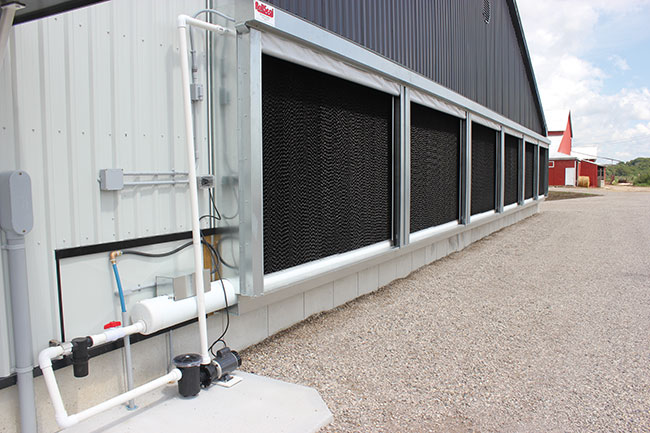As summer temperatures rise, commercial poultry operations face the critical challenge of managing heat stress—a condition that can significantly impact bird welfare, productivity, and profitability. Effective heat stress management is essential to maintain optimal performance in broilers and layers during hot weather.
🔍 Understanding Heat Stress in Poultry
Chickens are particularly susceptible to heat stress due to their limited ability to dissipate heat. Unlike mammals, they lack sweat glands and rely primarily on respiratory evaporation (panting) to cool down. When ambient temperatures exceed 77°F (25°C), birds begin to experience heat stress, leading to:
- Increased panting and wing spreading
- Reduced feed intake and growth rates
- Decreased egg production and shell quality
- Elevated mortality rates in severe cases
These physiological responses are the bird's attempt to maintain homeostasis but can lead to significant economic losses if not properly managed.
💨 Optimizing Ventilation Systems
Proper ventilation is the cornerstone of heat stress mitigation. Efficient airflow removes excess heat and moisture from the poultry house, creating a more comfortable environment for the birds. Key strategies include:
- Tunnel Ventilation: Utilize high-velocity fans to draw air through the house, effectively reducing temperature and humidity levels.
- Evaporative Cooling Pads: Install cooling pads at air inlets to lower incoming air temperature through evaporation.
- Regular Maintenance: Clean and inspect fans, inlets, and pads regularly to ensure optimal performance.
- Airflow Management: Ensure uniform air distribution to prevent hot spots and maintain consistent temperatures throughout the house.
💧 Ensuring Adequate Hydration
Water consumption can double or triple during periods of heat stress. To support hydration:
- Cool Water Supply: Provide cool, clean water at all times. Consider insulating water lines or flushing them during peak heat to maintain lower temperatures.
- Electrolyte Supplementation: Add electrolytes to drinking water to replace minerals lost through panting and to encourage water intake.
- Water Line Maintenance: Regularly clean water lines to prevent biofilm buildup, which can harbor pathogens and reduce water quality.
The Poultry Site emphasizes the importance of a reliable water source and the use of electrolytes to mitigate the effects of heat stress.
🍽️ Nutritional Strategies
Adjusting feeding practices can help reduce metabolic heat production:
- Feeding Schedule: Offer feed during cooler parts of the day (early morning or late evening) to align with birds' natural feeding behavior and reduce heat load.
- Diet Formulation: Incorporate higher energy diets with increased fat content, as fat produces less metabolic heat during digestion compared to protein and carbohydrates
- Wet Feeding: Providing wet feed can enhance feed intake and reduce body temperature in broilers.
- Antioxidant Supplementation: Include vitamins C and E, selenium, and other antioxidants to combat oxidative stress associated with high temperatures.
Research published in the Journal of Thermal Biology supports the use of dietary adjustments, including fat supplementation and antioxidants, to alleviate heat stress in poultry.
🏠 Housing and Environmental Modifications
Physical modifications to the poultry house can significantly impact internal temperatures:
- Roofing: Apply reflective coatings or install insulated roofing materials to reduce heat absorption.
- Shading: Plant trees or install shade cloths around the facility to minimize direct sunlight exposure.
- Insulation: Ensure walls and ceilings are adequately insulated to maintain stable internal temperatures.
- Litter Management: Maintain dry and clean litter to prevent additional heat and ammonia buildup.
The Poultry Site recommends these environmental strategies to create a more favorable microclimate within poultry houses during hot weather.
📊 Monitoring and Early Intervention
Implementing monitoring systems allows for proactive management:University of Maryland Extension
- Temperature and Humidity Sensors: Install sensors to continuously monitor environmental conditions.
- Behavioral Observation: Train staff to recognize early signs of heat stress, such as panting, wing spreading, and lethargy.University of Maryland Extension
- Emergency Protocols: Develop and rehearse response plans for extreme heat events, including backup power for ventilation systems.
The University of Maryland Extension highlights the importance of real-time monitoring and early intervention to prevent heat-related losses in broiler flocks. University of Maryland Extension
🧬 Genetic and Breeding Considerations
Long-term solutions involve selecting and breeding for heat tolerance:
- Heat-Tolerant Breeds: Consider using breeds or lines known for better performance under high-temperature conditions.
- Genetic Traits: Traits such as the naked neck gene have been associated with improved heat dissipation.
A study in the Journal of World Poultry Research discusses the potential of genetic approaches, including the use of specific genes, to enhance heat tolerance in poultry.
✅ Conclusion
Managing heat stress in commercial poultry requires a multifaceted approach, combining environmental control, nutritional adjustments, vigilant monitoring, and long-term genetic strategies. By implementing these evidence-based practices, producers can safeguard bird welfare, maintain productivity, and minimize economic losses during the challenging summer months.
📚 References
-
University of Maryland Extension. (2024). Summer Heat Stress Management for Delmarva Broiler Chicken Growers. University of Maryland Extension
-
The Poultry Site. (n.d.). Hot Weather Management of Poultry. The Poultry Site+1Penn State Extension+1
-
Journal of Thermal Biology. (2020). Impact of Heat Stress on Poultry Health and Performances, and Potential Mitigation Strategies. PMC+1jwpr.science-line.com+1
-
Journal of World Poultry Research. (2023). Poultry Management Strategies to Alleviate Heat Stress in Hot Climates. jwpr.science-line.com

